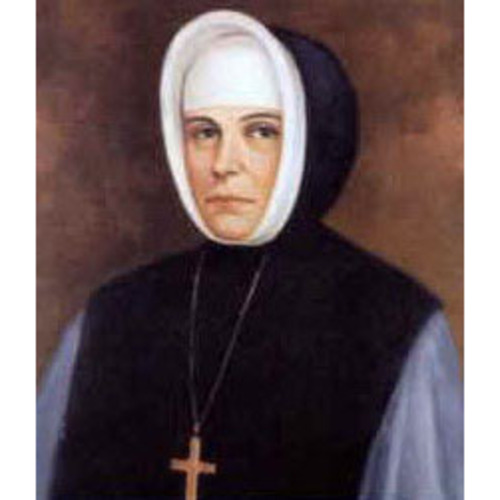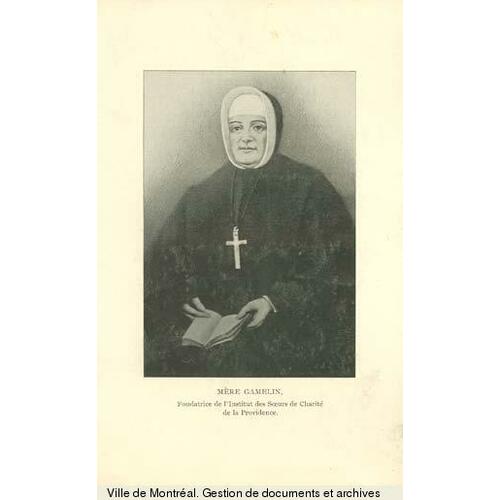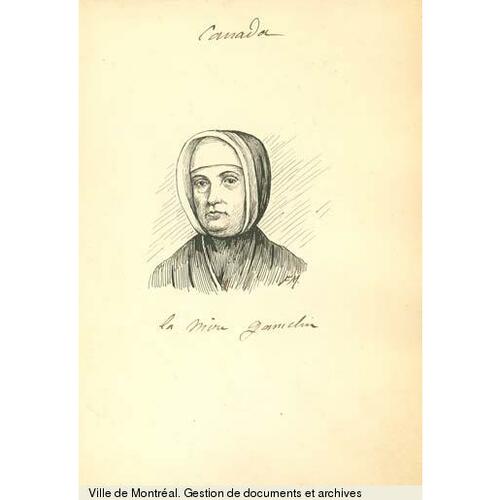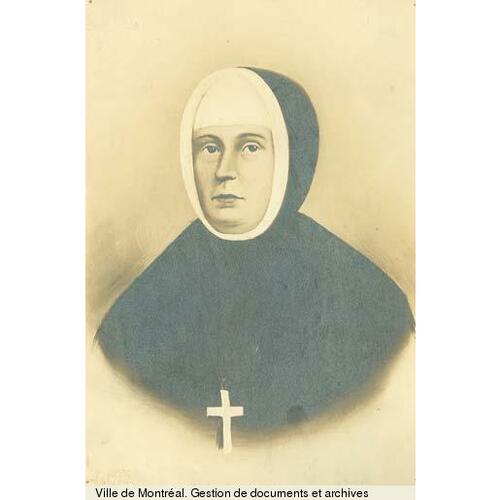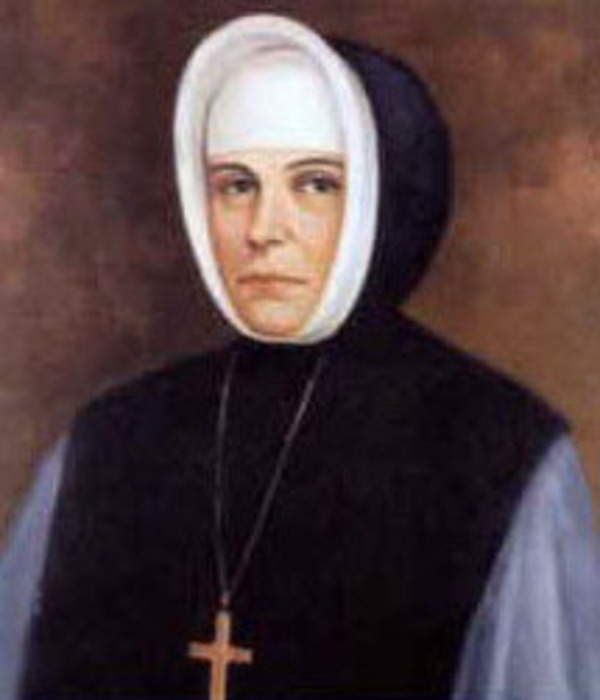
Source: Link
TAVERNIER, ÉMILIE (baptized Marie-Émilie-Eugène; she signed Amélie) (Gamelin), founder and first superior of the Daughters of Charity, Servants of the Poor; b. 19 Feb. 1800 in Montreal, daughter of Antoine Tavernier, a carrier, and Marie-Josephte Maurice; d. there 23 Sept. 1851.
Born of a father and mother, respectively of Picard and Norman ancestry, who were both Montrealers, Émilie Tavernier was the youngest of 15 children, only six of whom reached adulthood. Despite the precarious economic state of Lower Canada at the beginning of the 19th century, the Tavernier family was not impoverished. However, during her childhood and adolescence Émilie experienced a series of painful bereavements. She was not yet four when her mother died, and only 14 at the death of her father. In the intervening period she also suffered the loss of five more beloved relatives. Before her death Émilie’s mother had entrusted the girl to the care of her sister-in-law Marie-Anne Tavernier, the wife of Joseph Perrault, who was quite well off. Mme Perrault had four children, the youngest of whom, Agathe and Joseph, were still at home. She loved her niece as if she were her own daughter and saw to Émilie’s upbringing and education. Then for a couple of years she sent her to the boarding-school run by the Congregation of Notre-Dame, where she remained as a student probably until 1815. Émilie subsequently returned to her aunt’s house. In 1818 she went to look after her brother François, who had just lost his wife. When she came back to her adopted home the following year her aunt, who was now old and infirm, committed her to the care of her daughter Agathe; 13 years her senior and now the widow of Maurice Nowlan, Agathe became Émilie’s confidante and in effect her third mother.
By the age of 19, when she was taking care of her aunt, Émilie Tavernier was frequently to be seen at social gatherings. She rather enjoyed being in society and made many friends. Her company was sought after both in Montreal and in Quebec, where she stayed for two quite long periods between 1820 and 1822 to help one of her cousins, Julie Perrault, the wife of Joseph Leblond. She kept up a correspondence at that time with Agathe, to whom she confided on 18 June 1822 that she felt “a strong vocation . . . for the convent.” The letter went on, “I renounce for ever the young dandies and also the [vanities of this] world; I shall become a nun some time in the autumn.” However, to the surprise of her circle, on 4 June 1823 she married Jean-Baptiste Gamelin, a respectable Montreal bachelor of 50 who resided in the elegant faubourg Saint-Antoine and who made his living dealing in apples. Despite the difference in their ages, the marriage was a happy one, but it lasted less than five years for Gamelin died on 1 Oct. 1827; two of the couple’s three sons had died shortly after birth and the third survived his father by less than a year. Hence at the age of 27 Émilie Gamelin was again alone.
A widow with assets inherited from her husband, in the bloom of youth and in possession of all her charms, Mme Gamelin could easily have rebuilt her life. There was no dearth of suitors, but her feelings were changing. She was sorely tried by the death of her husband and children, and on the advice of her confessor, Jean-Baptiste Bréguier-Saint-Pierre, and of Bishop Jean-Jacques Lartigue*, auxiliary bishop in Montreal to the archbishop of Quebec, she began to take an interest in charitable works to assuage her grief. Towards the end of 1827 she joined two relief societies set up by the Sulpicians, the Confrérie du Bien Public, which sought work for a large number of unemployed, and the Association des Dames de la Charité, founded to help the victims of poverty and destitution then so numerous in Montreal. Home visits and the distribution of alms – charitable donations and money collected from those well off – constituted the main activities of the Dames de la Charité. The following year Mme Gamelin also joined the Confrérie de la Sainte-Famille, which aimed to foster the spiritual growth of its members and to encourage spreading the faith. Within these diverse bodies Mme Gamelin showed dedication and developed organizational skills. She also gave her assistance for a short period to the Charitable Institution for Female Penitents, which had been established in 1829 by Agathe-Henriette Huguet-Latour, the widow of Duncan Cameron McDonell. It was probably during this period that she began to divest herself of her properties, and to allocate the money from their sale to the relief of the poor under her care.
During her home visits Mme Gamelin was deeply touched by the physical and mental anguish suffered by frail or sick elderly women who had no one to support them and who faced a lonely death in unsanitary dwellings. To help them, on 4 March 1830 she opened a shelter at the corner of Rue Saint-Laurent and Rue Sainte-Catherine, in a building placed at her disposal by Claude Fay, the parish priest of Notre-Dame in Montreal. The dwelling soon proved too small, and the following year she rented a new one on Rue Saint-Philippe, which she managed and lived in with her first 15 boarders. The work of “providence” then began to take shape. In 1832 and 1834 cholera epidemics ravaged Lower Canada. Despite her fear of contracting the disease, Mme Gamelin regularly visited the cholera patients and succoured the sorrowing families of Montreal. By 1836 the home on Rue Saint-Philippe had in turn become too small. Mme Gamelin then appealed to Antoine-Olivier Berthelet*, a rich Montreal businessman and philanthropist. On 14 March Berthelet donated a house on the corner of Rue Sainte-Catherine and Rue Lacroix (Saint-Hubert), near the future episcopal palace. It was on 13 May, after several years of religious and political struggle, that the ecclesiastical district of Montreal was erected into a diocese, with Lartigue becoming its first bishop on 8 September. During the rebellion, Mme Gamelin obtained official permission to visit the imprisoned Patriotes who were under sentence of death; she put them in touch with their families and helped relieve their distress. Suffering from exhaustion, in March 1838 she fell seriously ill with typhoid fever, but she managed to recover and resumed her activity shortly afterwards.
On Lartigue’s death in 1840 Ignace Bourget* was appointed bishop of Montreal. That year also marked the beginning of a religious revival in Lower Canada. Bourget planned to set up a charitable undertaking capable of meeting the needs of the city’s poor. However, he had no intention of founding a religious community to handle it. He left for Europe on 3 May and went in particular to France, where he worked hard to persuade members of the Filles de la Charité de Saint-Vincent-de-Paul to come and put the planned endeavour on a permanent footing. During his absence the Legislative Assembly of the province of Canada on 18 Sept. 1841 incorporated Mme Gamelin’s old people’s shelter as the Montreal Asylum for Aged and Infirm Women. On 16 October, shortly after his return, Bishop Bourget affirmed his intention to entrust Mme Gamelin’s charitable undertaking to the Filles de la Charité de Saint-Vincent-de Paul; that very day the ladies who formed the corporation of the Montreal Asylum for Aged and Infirm Women, among them Mme Gamelin, decided to buy land and build a house which they called the Asile de la Providence. They elected Mme Gamelin head of the corporation on 27 October, and on 6 November, doubtless at her prompting, they purchased a property bounded by Rue Sainte-Catherine, Rue Lacroix, and Rue Mignonne (Boulevard de Maisonneuve), near the bishop’s palace. They decided on 20 December to begin construction at once. Thus the Asile de la Providence came into being. Mme Gamelin donated her last piece of property to its corporation on 16 Feb. 1842.
On 8 November Bourget learned that the Filles de la Charité de Saint-Vincent-de-Paul could not come to Montreal. He decided then and there to found a religious order and charge it with the responsibility of running the Asile de la Providence. On 25 March 1843 seven women responded to his call, and they started their noviciate under the direction of Jean-Charles Prince, a canon who in turn became coadjutor to the bishop of Montreal and first bishop of Saint-Hyacinthe. Mme Gamelin was not one of the novices, but Bourget was eager to associate her with his project and authorized her to serve as their superior. One of the novices withdrew on 8 July, and Mme Gamelin was free to take her place. However, before she entered upon her noviciate Bourget sent her to the United States to visit the Sisters of Charity, a community founded in 1809 by Elizabeth Ann Bayley Seton at Emmitsburg, Md, and gather information about the way they organized their good works and religious life. She brought back a handwritten copy of the rule of St Vincent de Paul which the bishop of Montreal wanted to give to his new Canadian community. On 8 October, shortly after returning, she took the novice’s habit. In a ceremony on 29 March 1844 Bourget conferred canonical status on the Daughters of Charity, Servants of the Poor, known later as the Sisters of Charity of Providence (Sisters of Providence). Then with the six other novices Mme Gamelin took the vows of chastity, poverty, and obedience, as well as a vow to serve the poor, and she received the name of Mother Gamelin. The next day she was elected superior of the new order.
Under Mother Gamelin’s leadership the young institute grew and soon launched several new charitable projects. The sisters took in orphan girls and elderly women boarders in 1844. In 1845 they opened the Hospice Saint-Joseph, to shelter elderly and infirm priests. That year they set up an employment office for those seeking and offering domestic work, and also began attending to the mentally ill. They opened two other homes in 1846, one at Longue-Pointe (Montreal) and the other at La Prairie. In 1847 Mother Gamelin aided victims of a typhus epidemic and assumed responsibility for the Hospice Saint-Jérôme-Émilien, a hospital for the children of Irish immigrants who had died of this illness; she also agreed to send some sisters to teach at the École Saint-Jacques, which was then short of staff. Two years later she opened a lazaret to assist those stricken by the cholera epidemic. At that time considerable progress was being made in the care of the insane, and she submitted to Louis-Hippolyte La Fontaine*, the attorney general of Lower Canada, a plan which led to the creation of an asylum at Longue-Pointe. The sisters established a convent at Sainte-Élisabeth, near L’Industrie (Joliette), also in 1849. The next year Mother Gamelin founded another at Sorel and made a second trip to the United States, where she visited the establishments of the Sisters of Charity, in particular their lunatic asylums.
When she returned in 1851 she gave her attention to putting matters in order at the Asile de la Providence. But her extraordinary involvement in charitable works during the preceding years had undermined her health. That year cholera again raged in Montreal. Her strength depleted, Mother Gamelin succumbed to it and died on 23 September after an illness of less than 12 hours. She was buried the following day in the vault of the Asile de la Providence. At the time of her death the Institute of the Sisters of Charity of Providence had 51 professed sisters, 19 novices, 5 postulants, and 7 homes which sheltered 110 poor and elderly women (some mentally afflicted), 95 orphans, 6 infirm priests, 16 female boarders, and 700 young pupils.
Mother Gamelin was the first French Canadian founder of a religious community in Lower Canada after the conquest. By her devotion to the elderly, sick, and needy, and through the charitable works she founded and helped establish, Mother Gamelin in the first half of the 19th century ensured that the gates of charity were opened for future generations.
ANQ-M, CE1-51, 20 févr. 1800, 4 juin 1823, 4 oct. 1827, 24 sept. 1851; CN1-134, 4 juin 1823. Arch. des Sœurs de la charité de la Providence (Montréal), Fonds Émilie Gamelin, A3.1, A3.5, A3.7. Can., Prov. of, Statutes, 1841, c.67. Mélanges religieux, 30 sept. 1851. F.-M. Bibaud, Le panthéon canadien (A. et V. Bibaud; 1891), 102. [Thérèse Frigon, dite] sœur Paul-du-Sauveur, “Essai de bio-bibliographie de la révérende mère Gamelin, fondatrice des Filles de la charité servantes des pauvres dites Sœurs de la Providence” (thèse de bibliothéconomie, univ. de Montréal, 1958), 1–22. [L.-A. Huguet-Latour], Annuaire de Ville-Marie, origine, utilité et progrès des institutions catholiques de Montréal . . . (2v., Montréal, 1863–82), 1: 70–82. Le Jeune, Dictionnaire, 1: 685–86. [J.-P.] Archambault, Sur les pas de Marthe et de Marie: congrégation de femmes au Canada français (Montréal, 1929), 93–99. [M.-J.-L. Blanchard, dite mère Marie-Antoinette], L’Institut de la Providence: histoire des Filles de la charité servantes des pauvres, dites Sœurs de la Providence (6v., Montréal, 1925–40), 1–2; 4; Notes historiques, 1799–1893, Sœurs de la Providence (Montréal, 1922), 61. Gustave Bourassa, Madame Gamelin et les origines de la Providence (Montréal, 1892), 15, 56–57. M.-C. Daveluy, L’orphelinat catholique de Montréal (1832–1932) (Montréal, 1933), 24–28, 314–16. N.-E. Dionne, Serviteurs et servantes de Dieu en Canada: quarante biographies (Québec, 1904), 212–19. [M.-L. Duchaîne, dite sœur Jean-Baptiste], Biographies de la mère Gamelin et de ses six compagnes fondatrices de l’institut des Filles de charité servantes des pauvres, dites Sœurs de la Providence (Montréal, 1918), 11–56. Henri Giroux, Une héroïne du Canada: madame Gamelin et ses œuvres (Montréal, 1885), 14–15, 17–18, 21–23. Maurice Hudon-Beaulieu, Mère Gamelin (Montréal, 1942), 6–27. Angelo Mitri, Mère Gamelin et sa cause de béatification ([Montréal], 1978), 3–7. Eugène Nadeau, La femme au cœur attentif: mère Gamelin (Montréal, 1969). Pouliot, Mgr Bourget et son temps, 2: 86–109. Irène Richer, Un cœur qui bat: itinéraire spirituel de mère Gamelin (Montréal, 1978), 30, 39, 69, 78. [Rose-de-Lima Tessier, dite sœur Rose-de-Marie], Vie de mère Gamelin, fondatrice et première supérieure des Sœurs de la charité de la Providence (Montréal, 1900), 7–10, 12–19, 24–25, 28, 30, 32, 91, 100, 102. Léon Trépanier, On veut savoir (4v., Montréal, 1960–62), 2: 179–80. É.-J.[-A.] Auclair, “Le centenaire des Sœurs de la Providence,” La Voix nationale (Saint-Justin, Qué.), 17 (1943): 12–13. Madeleine Durand, “Mère Gamelin et le service social,” CCHA Rapport, 28 (1961): 11–18. É.-Z. Massicotte, “Le refuge des filles repenties à Montréal,” BRH, 46 (1940): 373–77.
Cite This Article
Marguerite Jean, “TAVERNIER, ÉMILIE (baptized Marie-Émilie-Eugène) (Amélie) (Gamelin),” in Dictionary of Canadian Biography, vol. 8, University of Toronto/Université Laval, 2003–, accessed January 19, 2026, https://www.biographi.ca/en/bio/tavernier_emilie_8E.html.
The citation above shows the format for footnotes and endnotes according to the Chicago manual of style (16th edition). Information to be used in other citation formats:
| Permalink: | https://www.biographi.ca/en/bio/tavernier_emilie_8E.html |
| Author of Article: | Marguerite Jean |
| Title of Article: | TAVERNIER, ÉMILIE (baptized Marie-Émilie-Eugène) (Amélie) (Gamelin) |
| Publication Name: | Dictionary of Canadian Biography, vol. 8 |
| Publisher: | University of Toronto/Université Laval |
| Year of publication: | 1985 |
| Year of revision: | 1985 |
| Access Date: | January 19, 2026 |


